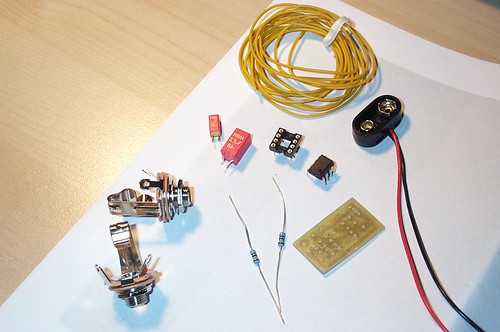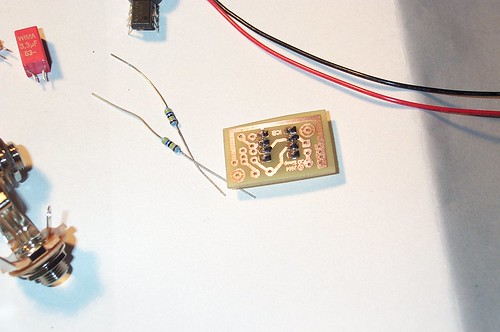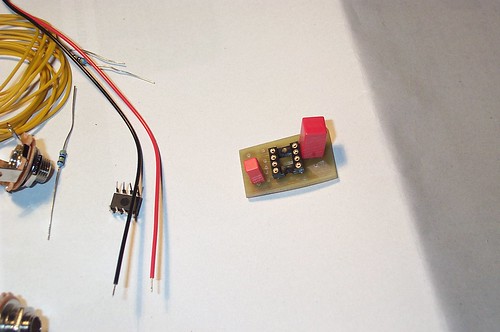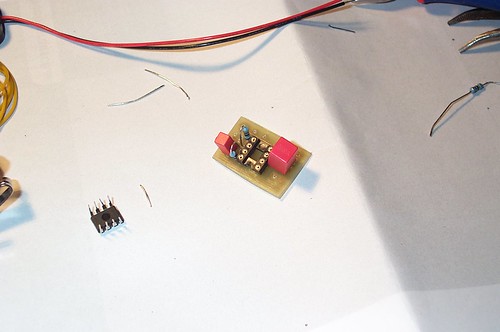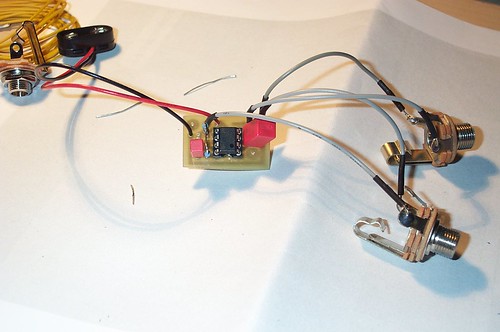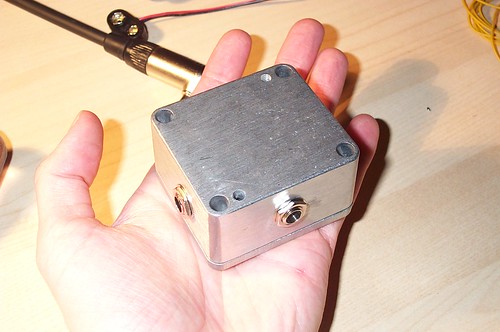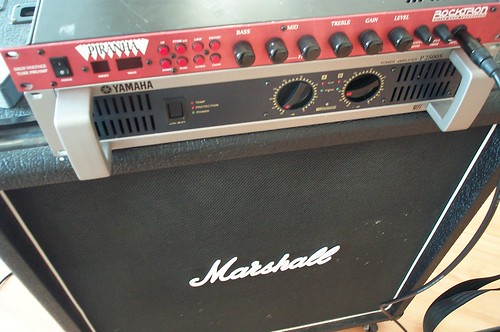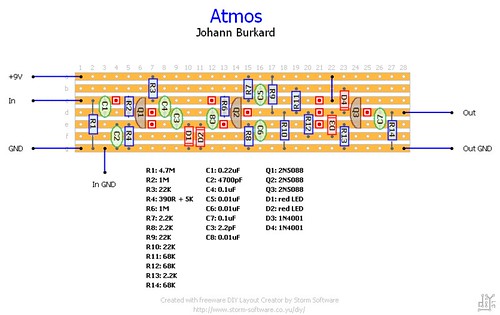Build a buffer
Posted 2007-03-10 in Effects by Johann.
In this tutorial, I’ll show you how to build a buffer pedal.
For an introduction to buffers, see Jack Orman’s “Basic Buffers” article.
List of parts
- 1 “Buffer - IC” board from General Guitar Gadgets (US$ 7)
- 2 4.7 MΩ resistors
- 1 single channel opamp, for example a TL071
- 2 capacitors (I used one 0.47 and one 3.3 µF WIMA capacitor)
- 1 8-pin DIL socket
- 1 stereo jack
- 1 mono jack
- 9 V battery clip
In my opinion, a buffer should be always-on, so from the schematics, I’ll omit R4 and the switching. You also don’t have to use my capacitor values, it’s just that they were the biggest polyester capacitors I had laying around. The original 0.1 µF and 10 µF values are fine, too.
Soldering the socket to the board
Put the socket on the board and solder it in.
Capacitors
Solder the smaller capacitor to the left side and the large one to the right side.
Resistors
The resistors go right next to the small capacitor.
Power, audio connections and the opamp
For testing purposes, solder the battery clip and the connections to the jacks directly to the board. Don’t forget to squeeze the opamp into the socket.
Note that the opamp was accidentally reversed in the above photo. The dot on the opamp’s case should point upwards.
Connect a battery and your buffer should work. That’s really all.
Where to go from here
All that’s left to do is to wire the GND connection (the black cable on the battery clip) to a stereo jack so that the circuit will only be active when a guitar is plugged in.
Of course, you’ll also need a case, for example a Hammond 1590B or a mini Bud case.
5 comments
Rocktron Piranha clip
Posted 2007-03-09 in Amplifiers by Johann.
Rocktron Piranha and Yamaha power amp plus a Marshall 1960B JCM800 cab.
Audio
Here’s a sound sample of the Rocktron Piranha.
Octaver pedal shootout
Posted 2007-02-22 in Effects by Johann.
In this shootout, I will compare five octaver pedals.
Danelectro French Toast
The French Toast is a copy of the Foxx Tone Machine. At 35 €, it’s the cheapest of the bunch. It’s not true bypass obviously.
The French Toast doesn’t really do low gain. At higher gains, there is a nice rubbery-ness that reminds me of “Spirit in the Sky.” At full gain, it’s an insane screaming wall of fuzz.
Dice Works Astronimus
The Astronimus is sold by the builder on eBay. The seller says it is a direct clone of one of the Octavia pedals Roger Mayer made for Jimi Hendrix. Like Mayer’s original, it uses two 9 V batteries.
The Astronimus does chords much better than the other effects. It also can be extremely loud. At lower gains, it is very sweet and full. At higher gains, it still stays dynamic.
Atmos prototype
The Atmos is a variant of the Dan Armstrong Green Ringer with an LED clipping frontend.
Like the original Green Ringer, it doesn’t have much sustain. Cranking the gain/volume control helps to some extent.
Burford Electronics Mosquito
The Mosquito is sold on the builder’s website and on eBay. The Mosquito has a two-way switch for “Mosquito or Swarm” and an output control labeled “attack.”
On the “Mosquito” setting, it strangely reminds me of my squarer prototype. The “Swarm” setting lacks sustain, but is cool for it’s insanity value. The maximum output volume is below unity gain.
Studio Electronics Helium
The Helium has a couple of extra switches – that don’t do much in reality. The “mix” potentiometer is nice though.
The basic character is rather bright. There also is a lot of gain available.
Sound clips
- Clean sound: MP3 400 KB, Ogg Vorbis 240 KB
- French Toast low gain, then near full gain: MP3 4.6 MB, Ogg Vorbis 2.8 MB
- Astronimus: MP3 2.3 MB, Ogg Vorbis 1.3 MB
- Atmos, first low gain, then cranked: MP3 2.3 MB, Ogg Vorbis 1.4 MB
- Mosquito, first “Mosquito,” then “Swarm:” MP3 5.0 MB, Ogg Vorbis 3.0 MB
- Helium: MP3 2.3 MB, Ogg Vorbis 1.3 MB
All soundclips were recorded from an Ibanez 2027XVV 7-string through the pedal into a Boss VF-1 effects processor that did amp and cabinet simulation, some delay and some reverb.
Conclusion
For the money, the French Toast can’t be beat. The Mosquito is also a nice choice at around 90 € but not always available (and needs a boost). The Helium isn’t all that exciting but slightly more flexible than the others (around 200 €). The Astronimus (around 150 €) is a different sound that works well slamming an amplifier.
2 comments
Building Atmos pedals
Posted 2007-02-05 in Effects by Johann.
A while ago I seriously considered building pedals regularly. As it turns out, I’m really slow at building pedals (although I have much better tools now), so I’ll just release my designs and let everyone enjoy them (or not).
The first one is called Atmos – it’s a Green-Ringer-inspired circuit that sounds very atmospheric.
Enjoy the circuit and let me know if there are any problems.
Pages
Page 18 · Page 19 · Page 20 · Page 21 · Page 22 · Page 23 · Page 24 · Next Page »
Subscribe
RSS 2.0, Atom or subscribe by Email.
Top Posts
- DynaCloud - a dynamic JavaScript tag/keyword cloud with jQuery
- 6 fast jQuery Tips: More basic Snippets
- xslt.js version 3.2 released
- xslt.js version 3.0 released XML XSLT now with jQuery plugin
- Forum Scanners - prevent forum abuse
- Automate JavaScript compression with YUI Compressor and /packer/
